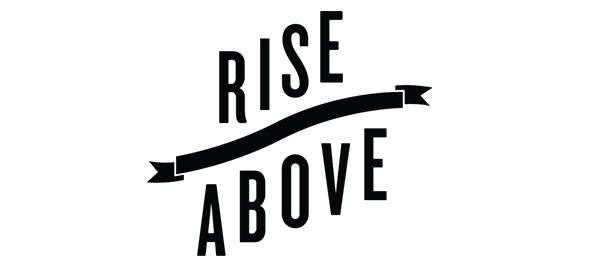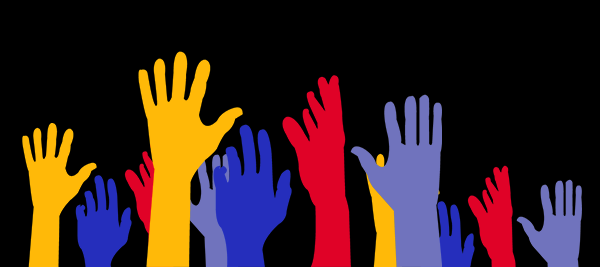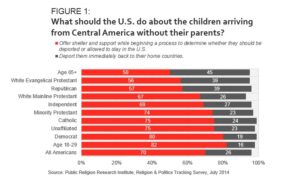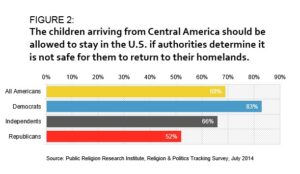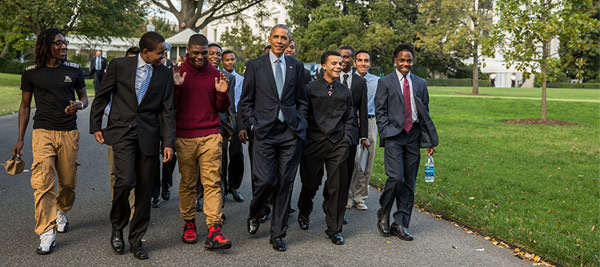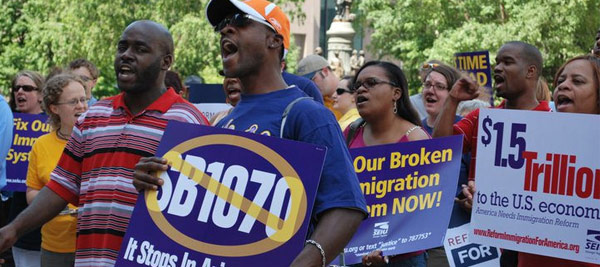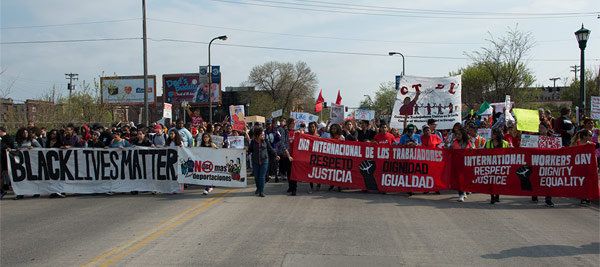Media Depictions and Media Consumption
Acknowledgments
This research was authored by Topos Partnership (Executive Summary; Social Science Literature Review: Media Representations and Impact on the Lives of Black Men and Boys; and A Review of Public Opinion Research Related to Black Male Achievement) and Marc Kerschhagel (Media Market Research: Media Consumption Trends Among Black Men), with consultation from Janet Dewart Bell and Eleni Delimpaltadaki Janis of The Opportunity Agenda, who contributed to the design and analysis of the research and edited the report. Christopher Moore designed the report. Jill Bailin, Judi Lerman, and Loren Siegel also assisted in the editing of the report.
The Opportunity Agenda’s research on black men and boys is funded by the Open Society Foundations’ Campaign for Black Male Achievement. The statements made and views expressed are those of The Opportunity Agenda.
Our sincerest gratitude goes out to the advisory committee, who consulted on this research: Bryonn Bain, Robert Entman, Fanon Hill, Dori Maynard, Alexis McGill Johnson, Rashid Shabazz, Calvin Sims, Kamal Sinclair, Alvin Starks, Albert Sykes, Sharon Toomer, Rhonda Tsoi-A-Fatt Bryant, Cheo Tyehimba Taylor, and Hank Willis Thomas. Special thanks to Steve DuBois, who coordinated the committee.
Executive Summary
Over the past half-century, African Americans have made remarkable progress in toppling legal segregation and discrimination, in accessing economic and educational opportunities, and in participating in our political process, including, most notably, as President of the United States. Yet significant barriers remain in countless domains, from high school graduation to employment and wealth, to physical health and the criminal justice system. And in each of those areas, African-American men and boys face challenges that differ in key respects from those of African-American women and girls, or from men and boys of other racial and ethnic groups.
Among the many factors that influence the opportunities and achievements of black men and boys are public perceptions and attitudes toward them as a group, and their own self-perceptions as well. Research and experience show that expectations and biases on the part of potential employers, teachers, health care providers, police officers, and other stakeholders influence the life outcomes of millions of black males, just as their own self-esteem, identity, and sense of empowerment affect their ability to achieve under difficult circumstances.
In turn, one of the most important avenues for maintaining (or changing) these perceptions is the mass media, with its significant power to shape popular ideas and attitudes.
Academics and advocates have spent significant time investigating the relationships among black outcomes, media representations, and other aspects of public discourse. However, this research has not been fully integrated into the work of advocates and organizations seeking to make change, in part because the findings are diffuse and even conflicting, and in part because they have frequently not been translated into actionable recommendations. To foster the incorporation of this research into the work of those trying to improve black male achievement, The Opportunity Agenda has commissioned a set of reports that review and summarize the key findings and recommendations in three significant areas:
- A review of the social and cognitive science literature to determine what researchers know and don’t know about the relationship between media representations and the media’s impacts on the lives of black men and boys;
- A meta-analysis of public opinion research relating to race, and what it suggests about advocacy for black male achievement; and
- An analysis of original data about black men as consumers of media, including broadcast, print, and online platforms.
In each case, the rationale for the report is to offer a clearer picture of what is already known about how engagement with the mass media and public communications may help improve the life chances of black men and boys. This research overview offers a brief summary of some of the key content from those reports, and readers are urged to pursue the exploration further in the reports themselves.
In reporting our findings and recommendations, we use interchangeably the terms “black” and “African American” to describe people who identified themselves using either of those terms in response to the research on which our analysis is based. In the Media Consumption Trends among Black Men portion of this report, we use the term “men” to describe males 18 years of age or older.
Findings
A review of social science literature and public opinion research relating to black male achievement
Hundreds of scholars in a range of disciplines — from experimental psychology to cultural criticism to sociology to ethnic studies — have explored questions relating to how media, and communications more broadly, affect outcomes for black men and boys in American society. In addition, dozens of recent public opinion studies have touched on Americans’ understandings of black achievement, awareness of racial disparities, and thoughts about the causes of and responsibility for addressing inequalities.
The reviews of this large body of work offer a digestible overview of an extremely rich and varied collection of research. Some themes and findings are well established and deeply documented in the literature, while other areas remain to be investigated further, or raise challenging questions with which scholars continue to grapple.
Distorted Patterns of Portrayal in the Media
One of the best-documented themes in the research is that the overall presentation of black men and boys in the media is a distortion of reality in a variety of ways. While individual studies may focus on a single genre or medium — such as TV fiction shows, magazine advertising, or video games — the research taken as a whole reveals broad patterns, including the underrepresentation of African Americans (and black males in particular) in a variety of roles such as “talking head” news experts, computer users in TV commercials, and “relatable” characters with well-developed personal lives (e.g., fathers). Conversely, black males are overrepresented when media touch on certain negative topics, such as criminality, unemployment, and poverty, for instance. Also, the positive images and attributes with which black males are associated tend to be constrained to a small, stereotypic set which includes sports, physical achievement in general, aggressiveness, and musicality, to the exclusion of other everyday virtues.
The social science research also makes clear that important dimensions of black men’s and boys’ lives are largely ignored in the media — such as historical antecedents of black economic disadvantage and the persistence of anti-black male bias.
Especially problematically, scholars conclude that even “accurate” and “sympathetic” representations of black males can indirectly misrepresent reality: When reporters continue to explore real problems facing black communities and black men and boys, they may end up reinforcing the “problem frame” that associates these groups with intractable challenges.
Perceptions of African Americans
According to researchers, distorted media representations can be expected to create attitudinal effects ranging from general antagonism toward black men and boys, to higher tolerance for race-based socio- economic disparities, reduced attention to structural and other big-picture factors, and public support for punitive approaches to problems.
In fact, a wealth of studies confirms that negative perceptions of African Americans linger in the American mind. A large body of research explores the nature of “implicit bias,” unconscious attitudes that are presumably shaped in part by media consumption. Experiment after experiment demonstrates that white Americans tend to have unconscious biases against African Americans. For instance, whites tend to more easily associate negative words such as terrible, failure, horrible, evil, agony, nasty, and awful with unknown black faces, as opposed to white faces. To a lesser degree blacks too tend to show this bias against unknown faces of their own race.
Explicit measures of bias also confirm lingering negative attitudes. While there has been significant improvement in racial attitudes since the mid-twentieth century — as measured in surveys touching on black-white relations, segregation, and blatant prejudice — racial tensions and stereotypes persist. Some recent public opinion research has measured public assessments of different racial groups, including character traits, finding that Americans overall give higher ratings to “white Americans” than to “black Americans.”
These perceptions, in turn, can create negative effects any time a black man or boy is in a position where his fate depends on how he is perceived by others, particularly by whites, or on the kind of rapport he has with them. Real world impacts documented in the literature include less attention from doctors, harsher sentencing by judges, lower likelihood of being hired or admitted to school, lower odds of getting loans, and a higher likelihood of being shot by police.
While studies show that media images have the most impact on viewers with less real-world exposure to the lives of African Americans, African-American audiences are not immune. Scholars point to a connection between media consumption and diminished black perceptions of self, which may arise by various mechanisms. For instance, negative stereotypes such as portrayal of blacks as thugs, criminals, fools, and disadvantaged are demoralizing and reduce self-esteem and self-expectations. Dealing with negative expectations may also create stress and drain cognitive resources in some contexts — leading to the lowered performance associated with “stereotype threat.” It may also be significant that the common “role models of success” (e.g., rap stars and NBA players) imply limited options, while other types of role models are lacking. The importance of this narrow range of models is amplified when we consider that sports (especially football and basketball) and music programming dominate the television and radio preferences of black men and boys. (See below for discussion of media consumption habits.)
In the end, black men tend to be their own harshest critics, according to public opinion research. They tend to believe that members of their group put too little emphasis on health, success at work, family, and other important areas. (Yet while black respondents express significant worries and see a great number of problems facing black men, they nonetheless express strong optimism about their group’s future.)
Perceptions of Inequality and Causal Factors
Given the observation by social science researchers that the media present little information about structural factors affecting life outcomes for black men and boys, we might expect limited public awareness and understanding of these factors as well. And in fact, public opinion research confirms that this is the case.
A first pattern to note is that few surveys even include questions about structural factors per se — e.g., the need to improve public transit access in particular neighborhoods. Rather, they tend to emphasize questions that take an interpersonal perspective on race issues — e.g., focusing on how people get along or whether blacks experience racial slights. On these measures, most Americans believe that race relations are good, that problems will be worked out, and that more dialogue will help. Blacks are more likely to report discrimination and to believe that discrimination is at the root of various serious consequences, such as disparities in income and education. (Even more fundamentally, white respondents tend to underestimate the gaps themselves: They are less aware of the disparities that face black Americans, and are more likely than blacks to believe that disparities are disappearing.)
In addition to the interpersonal perspective, surveys also measure attitudes related to personal responsibility as a root cause for racial inequality — i.e., the idea that disparities exist because individuals of different races are not trying equally hard to achieve. This view is common among all races, and black respondents themselves have increasingly shifted toward a personal responsibility perspective to explain gaps in black achievement since the mid-1990s, although this view has not yet replaced the belief that prejudice hinders achievement.
In the few cases where opinions regarding structural factors are measured, surveys find differing perspectives between racial groups. For example, most black people believe the economic system is stacked against them, while white Americans tend to think “the system is fair to everyone.”
Causes for Distorted Patterns in the Media
Why are media patterns distorted? Social science scholars have offered a number of suggestions about the causal factors leading to the distortions and omissions, such as the fact that media content producers themselves may have distorted perceptions, or may make incorrect assumptions about what audiences want to see or who their audiences are. Some suggest that media-makers may be accurately reflecting and responding to the appetites and preferences of consumers who prefer these distortions, or may be working towards political ends by trafficking in stereotypes. One of the factors treated as most significant is the paucity of African-American producers, journalists, invited guest experts, and other shapers of content.
Deep Challenges
Beyond describing the negative impacts of distorted and incomplete media portrayals, the social and cognitive science literature points to a number of deep challenges that confront anyone hoping to make a real difference in perceptions. For instance:
- Anxieties tangential to race, e.g., about terrorism or job loss, tend to promote a more conservative outlook, including negative attitudes towards those perceived as “other.”
- Some social science suggests relations among people of different races must always overcome some fundamental obstacles, such as more trouble differentiating the faces of other-race individuals.
- There is considerable debate about how to discuss the degree to which the actions and choices of black men may contribute to their problems and reinforce the default perception that they are entirely and always at fault.
- Some of the social science literature suggests that actual social contact between black men and boys and others may be one of the most critical factors in changing perceptions and outcomes. If this is the case, then communications attempting to change perceptions of black men and boys per se, no matter how well done, may be of secondary importance, except to the extent that they help break down the forms of isolation and segregation that marginalize black men and boys.
Relative Lack of “Prescriptive” Studies
The vast majority of the literature on this topic focuses on mapping out the problems relating to black men and boys and the media, and is essentially descriptive — that is, it describes and analyzes existing patterns in the media and their impacts on thought and behavior. Prescriptive studies, explicitly setting out to identify proven courses of action, including empirically testing hypotheses about what might help improve matters, are relatively absent from the literature.
An exception to this trend comes from laboratory studies of tasks or conditions that reduce implicit (unconscious) bias. For instance, various types of explicit and intensive training have been shown to reduce measures of implicit bias.
By and large, however, the existing research offers relatively little evidence about what works when it comes to improving media representations of black men and boys, or addressing the adverse effects of such representations.
Media consumption trends among black men
Those who hope to make changes in the media environment that shapes perceptions of and by black men and boys must understand how this group experiences and interacts with the media. For instance, if the goal is to influence content viewed by this audience, it will be helpful to focus on media venues that are both very popular and potentially amenable to content input. We examined a wide range of media platforms — including television, magazines, online outlets, newspapers, and radio — and identified the media sources, whether mainstream or targeted to this population, with the highest reach to African-American men. The results provide valuable information to those seeking to influence the media content received by this group.
The research shows that across all media platforms, sports (primarily football and then basketball) and music (Urban Contemporary and Urban Adult Contemporary) dominate the media preferences of African-American men. Mainstream media reaches the most African-American adults (men and women) in general, while ethnic media reaches fewer, but in a higher concentration. Both overall reach and concentration are important factors that should inform the design of media interventions.
Compared to the average media consumer, African Americans watch less TV news overall but are more likely to watch local news and cable news. They are also more likely to get news from the internet and less likely to read the newspaper.
Highlights of findings across all platforms and in each media platform follow.
Cross-Platform Findings
Across media platforms, sports and music-related media content are the most embraced by African- American men. Mainstream media, as expected, reach larger numbers of African-American men, and African-American adults in general, than media that specifically target these populations. However, African-American targeted media tend to have significantly higher concentrations of African-Americans among their consumers, and in a few cases — such as with the magazines Ebony, Jet, or Essence — they also deliver large reach.
- Specific online search, web portals, aggregation and social media sites (Google, Yahoo!, Facebook, and YouTube) and televised sporting events (NFL and NBA) reach the largest absolute numbers of black men. Outside of advertising, however, opportunities to influence the content of many of these platforms are limited.
- Among platforms that generate their own editorial or entertainment content, magazines reach the largest numbers of black men. Nine out of the top 10 “content-generating” media sources across all platforms are magazines, and their reach to African-American men is a little over 20 million. These titles include: Ebony, Sports Illustrated, ESPN The Magazine, Jet, National Geographic, Men’s Health, Black Enterprise, Essence, and People.
- Among black-oriented media, lifestyle magazines and music-related TV shows top the list.
Television
- On television, sports dominate the viewing habits of African-American men. The popularity of sports, specifically the NFL, mirrors that of the U.S. population overall, except that the NBA finals are by far more popular with the African-American community than with the general population. All of the top 25 viewed shows by all African-American adults, as well as by African-American men, are sporting events (NFL and NBA, with 10 and 4 million viewers, respectively).
- Secondary to the popularity of sports events on television are music-related programs. In this and many other arenas, broadcast television has significantly larger reach to African Americans than cable.
- The highest viewed non-sporting event by African Americans is the Grammy Awards. At 3.3 million viewers, it is the only non-sporting event/show in the top 55. Looking deeper, six of the top ten most watched non-sporting shows by African-American adults are music related: The Grammy Awards, Glee, The Academy Awards, Dancing with the Stars, American Idol, and Soul Train Red Carpet.
- On TV, Black Entertainment Network (BET) offers the most competitive combination of large reach and high concentration of African Americans. BET shows predominated the list of the top most watched non-sporting shows by this population.
- The Fox Networks have more shows geared towards African Americans, with a larger reach to African-American men, than any of the other major networks (ABC, CBS, and NBC). Among the most popular of these are the variety show In the Flow and the NAACP Image Awards. Comedies such as Are We There Yet? on TBS are popular with African-American men and adults, although they do not compete with NFL, NBA, or music-related TV programming, nor with readership of top magazines, such as Ebony, Jet, Black Enterprise, and Essence, whose reach is to the target audience.
- TBS is the only mass media cable network with shows targeted at African Americans — Tyler Perry: The Family that Prays and Are We There Yet? — which have a large audience of African- American men.
Magazines
- Magazines are the only national media platform where combined black-oriented titles reach larger absolute numbers of African-American men than do mainstream titles. In the other media platforms that are distributed on the national level (TV, online, and newspaper), the properties with the largest black adult audiences are geared toward the general population and not specifically to the African-American community.
- Four of the ten magazines reaching the largest African-American male audience — Ebony, Essence, Jet, and Black Enterprise — are black-oriented magazines with lifestyle content. Their reach to African-American men ranges from 1.7 to 3.5 million.
- The second most popular magazine genre among African-American men is sports. Sports Illustrated and ESPN The Magazine are the second and third most popular magazines, with 3.1 million and 3 million African-American men, respectively, reading them monthly.
- The magazine preferences of African-American men resemble those of the African-American adult readership as a whole. Eight of the top eleven magazines with the largest readership by African-American men are also within the top eleven in African-American adult (male and female) readership.
Online
African Americans are using the internet in higher percentages than in years past. An estimated 67 percent of African-Americans are currently online, according to a Pew Internet & American Life survey conducted in May 2011,1 compared with 78 percent of Americans overall. The present analysis found:
- African-American adults’ online habits are very similar to the general adult population of the U.S., with Google, Yahoo!, Facebook, YouTube, and Twitter being among the most popular sites.
- African Americans are more socially active online than other ethnic groups. African-American adults, and African-American men specifically, regularly visit social media sites.2 Nearly 12 million African-American adults visit Facebook each month, including 4.65 million African-American men, making it the third most popular site for both groups. Twitter and MySpace are also very popular among both groups.
- Like American adults in general, African Americans go regularly and in large numbers to specific content sites such as YouTube, About.com, Weather.com, ESPN.com, and Yahoo! (which is also a web portal). These sites have anywhere from almost 1.5 million (ESPN.com) to almost 13 million unique visits (Yahoo!) from African-American adults, and from almost a million to almost five million unique visits from African-American men, respectively.
- Four of the top six most popular content sites among African-American men are either entirely devoted to music or have a music component to their site: World Star Hip Hop, Black Voices, BET Interactive, Bossip.com, and DatPiff.
Newspapers
- Relative to the other media platforms, newspapers have a smaller reach to African Americans and African-American men in particular. Yet because they are often neighborhood-specific, they are a good vehicle for reaching particular geographic locations.
- There are four newspapers, two in the Chicago media market — Chicago Sun Times and RedEye — and two in the Washington, D.C., media market — Examiner and Express — in which African- American men are overrepresented in their readership relative to their presence in the population, ranging from 14 to 25 percent of readers of these newspapers.
- The three newspapers with the largest absolute numbers of black men are the Chicago Sun-Times, the New York Daily News, and USA Today. However, black men still comprise less than 15 percent of the readership of these papers.
- Among all black-oriented papers we examined, only two have a circulation over 100,000: N’DIGO and The Chicago Citizen, which both serve the Chicago media market. Overall, the median circulation of African-American targeted newspapers is 30,000, compared to 386,000 for mainstream newspapers.
Radio
- Black men listen to music-oriented stations more than any other stations, and the most popular ones tend to follow the Urban Contemporary and Urban Adult Contemporary formats — except in the New York media market, where Rhythmic Contemporary radio is dominant.
- Radio news stations have a relatively small reach to African-American men and African-American adults altogether. Although in most of the media markets we analyzed the list of the top ten stations includes one or even two news stations, their reach to African-American adults (men and women) is a fraction of the reach of music stations.
Recommendations
A review of social science literature and public opinion research relating to black male achievement
A persistent finding in recent public opinion research is that white and black perceptions of equal opportunity are at odds. The two populations have different understandings of what the issue is “about”— i.e., what the relevant causal factors are, who the players are, and so forth. The good news in this finding is that since these are the kinds of challenges that communications reframing can often address, there is cause for optimism regarding successful interventions.
While the existing research does not offer a great deal regarding particular ways forward, a review of this work does suggest a number of ideas that communicators should keep in mind as they work towards the rigorous communications strategies that can help create social change.
Communicators need to continue to create fuller and more accurate portrayals of black men and boys in the media through education and external pressure targeted at media producers, and by working to embed more African Americans in all links of the media production chain. Our research focusing on African-American men’s media consumption habits offers recommendations (see page 9) on specific media sources based on their reach to this population, which advocates should consider.
Advocates must also wrestle with significant questions of how to talk most effectively about the topic in order to take the best advantage of communications opportunities — especially given all the challenges discussed above. There are a number of important aspects to the challenge communicators must face, including:
- Explaining the role of structures and systems in leading to disparities, thereby helping people see past the “personal responsibility” and “personal racism” perspectives. If a person believes discrimination is largely a thing of the past, or that discrimination is solely about interpersonal slights and personal racism, or that success is due solely to personal pluck, a policy conversation can seem irrelevant.
- Finding new and compelling ways to address causes, rather than focusing solely on disparities, which can easily lead to counterproductive conclusions about who is responsible.
- Look for ways to characterize the unique challenges facing black men and solutions to the challenges without inadvertently implying that other groups will have less opportunity, e.g., “breaking down obstacles” instead of “addressing disparities.”
- Calling attention to effective solutions. Communicators can be confident that promoting stories about solutions and success stories — interventions or causal factors of any kind that have altered black male outcomes for the better — will help engage new audiences.
- Breaking the in-group/out-group cycle and establishing a sense of “we,” reinforcing shared fate and interdependence. How are the fates of all Americans linked, regardless of race and gender?
- Sharpen objectives and strategies for different audiences. Clearly this research suggests different starting points for the conversation with different racial groups. Black Americans are far more likely to see the systemic flaws that lead to disparities and support government action (though the personal responsibility perspective is gaining ground), while few white Americans even recognize the breadth and severity of traditional discrimination, let alone institutional racism.
- Promoting new perspectives and policies specifically in the areas of jobs, education, and criminal justice. These are the top three issue priorities for black families and black men, and there are reasons to believe that each offers promising communications opportunities:
- All Americans see a collective stake and a collective responsibility for education, and this is an area that most strongly connects collective responsibility to economic mobility.
- The current weak economy has made the role of broken systems more visible, as people think about their economic wellbeing. Black Americans, in particular, support an active, engaged government role in addressing the problem. On the other hand, communicators should note that any framing which implies benefits to one group (such as black men) at the expense of another is likely to strongly backfire with the general public; and that it will take careful framing to help many white audiences see government as part of the solution rather than part of the problem.
- Although crime has declined as a national priority, black Americans rate it as a top priority. They also see police bias as a serious problem, and have low confidence in the justice system generally. A significant minority of white respondents admit that black Americans may receive different treatment in the justice system.
- One promising candidate for a focus of discussion may be implicit bias itself — as identified in psychology experiments. As a focus of communications, these points illustrate several criteria that our own research suggests can be important for effective communication on a fraught topic: (A) steering clear of the type of moral censure that can alienate many audience members; (B) pointing to “objective” facts that are harder to dispute; (C) conveying a relatively novel and unfamiliar point (rather than rehashing familiar claims and accusations); and (D) offering the hope that there are concrete steps that can help.
- Despite the useful body of knowledge that exists, additional research is needed to further test and hone language that is best for engaging different audiences — including effective spokespeople — in these conversations.
Media consumption trends among black men
The analysis of media consumption trends suggests a number of recommendations for those hoping to reach black men with positive content and information, or to improve depictions in the media that they consume:
- Sports and music content reach large numbers of black men through television, radio, magazines, and other media. Working with celebrities — who are the subject of interviews and feature stories, as well as creative and athletic content — as spokespeople is therefore one way to reach a broad audience. Fostering coverage of sports and music figures’ positive activities and activism as part of popular existing programming is a related avenue.
- Magazines can be particularly fruitful vehicles for communicating positive messages to and about black men and boys, both because they create their own content and because their black readership is high. Outreach to magazine publishers, editors, and authors could inform and increase the content relative to black men and boys. Johnson Publishing, which owns Ebony and Jet, is a particularly influential publisher with this audience, as is Time Inc., which publishes Sports Illustrated and People. Editorial meetings, story pitching, and advertising with these outlets are all possible strategies.
- Fox Networks and TBS each have black-oriented shows that reach a broad audience of black men, including sitcoms, variety shows, and awards ceremonies. Seeking to inform the content of these shows and their stars is a promising avenue. Public service announcements and paid advertising may also prove fruitful.
- The NAACP Image Awards show presents a particular opportunity. Because its purpose is to elevate positive images, the show can be further leveraged to convey constructive messages and information about and for African-American men.
- BET Network offers a unique combination of large numbers and a high concentration of African- American men as well as women. Working to inform the content of BET shows by pitching or even creating new content can influence a large audience, as may public service announcements and paid advertising on BET.
- While specific search, web portals, aggregation and social media sites that are very popular, such as YouTube, Google, Yahoo!, and Facebook, do not create their own content, they do highlight the possibility of user-created content (such as YouTube videos) capable of reaching black men, who tend to be active in social media, particularly on Facebook. These websites are prime vehicles for reaching this population, as well as black youth. While online advertising is in flux, it should also be monitored for possible interventions.
- While newspapers reach relatively small numbers of black men overall, they can be employed to reach people at the local level, especially regarding neighborhood information and opportunities.
Finally, additional research is needed in a number of areas in order to determine the best strategies for reaching and informing the thinking of this population. Priorities include:
- Further disaggregating the demographics of the black male community in terms of age, education, income, and other aspects relevant to their advancement. This should include studying the consumption habits of black boys.
- Identifying other audiences — such as employers, educators, and law enforcement officials — whose perceptions of black men and boys are important to their success and safety. The media consumption of these audiences should also be identified.
- An in-depth analysis of the digital world is necessary, given the increasing penetration of these media into the lives of all Americans. Technology, as well as people’s behavior online, is changing at such a fast pace and with so many different platforms (search engines, content creators, social networks, mobile phones, and tablets) that it is important to gain a greater understanding of the digital world and its influence on African-American men and boys.
- An analysis of how African-American men and boys consume media would offer insights into the way information on different platforms engages this population and how communicators can leverage them. People consume information differently on different platforms, acquire it differently, and frequent it differently. For example it is important to know whether African-American men and boys are going to a specific site via their desktop, cell phone, or tablet; whether they subscribe to a magazine or buy it on the newsstand; how much time they spend reading a specific magazine compared to the length of time they spend on a specific site or watching a television program.
Notes:
1. Pew Research Center, Pew Internet & American Life Project’s Spring Tracking Survey “Usage Over Time,” May 2011.
2. Georgetown University, Center for Social Impact Communications and Ogilvy Public Relations Worldwide, “Social Media Plays Greater Role in Cause Engagement For African Americans and Hispanics,” May 31, 2011.

